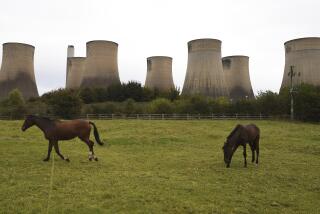Closing coal power plants has saved thousands of lives, study says
Study also estimates more than a half-billion bushels of crops have been saved
- Share via
The number of coal-fired power plants in operation across the country has plummeted in recent years, quickly changing the power mix — especially in states such as California.
But what has that change meant in terms of health? Or even in the number of crops produced?
In a study published this month in the journal Nature Sustainability, UC San Diego associate professor of environmental science Jennifer Burney has estimated that between 2005 and 2016, the shutdown of coal-fired units saved 26,610 lives and 570 million bushels of corn, soybeans and wheat in the combined areas where the plants closed.
Burney’s study also came up with an inverse estimate: Plants that remained in operation contributed to more than 329,000 premature deaths and the loss of 10.2 billion bushels of crops. That’s about half the production in the U.S. in a typical year.
“We know that coal-fired power plants produce a bunch of different pollutants and we know that pollution is bad for human health,” Burney said. “But I think this study puts some hard numbers on that.”
Burney came up with the estimates by poring over data from sources such as electric power generation numbers from the Environmental Protection Agency, mortality figures from the Centers on Disease Control and satellite data from NASA that monitors pollutants. She also looked at the specific areas surrounding power plants before and after they shut down.
And more are closing their doors.
In 2005 coal accounted for 50% of the power supply in the U.S., but it has fallen to 27% by the first half of 2018, according to the U.S. Energy Information Administration. Coal-fired generation is expected to drop an additional 13% this year.
Coal production in California is practically microscopic. There is just one operating plant left in the state — the 63-megawatt Argus Cogen plant in Trona — and according to the California Energy Commission’s latest numbers, coal accounted for 0.15% of in-state generation.
California does import electricity from coal-fired plants in other states, but in 2018 the amount came to 3.3% of the state’s power mix and the Energy Commission expects the share to drop to almost zero by the end of 2025.
Burney said “this really vast transition” that has led to coal plants shutting down prompted her to try to measure the interplay between the retirements and factors such as pollution, death rates and crop yields.
A skeptic may question the estimates Burney’s study produced but she said the numbers aligned along very different locations in very different moments in time.
“It statistically just becomes very improbable that something else is causing it,” she said.
As coal plants have closed, the number of natural gas plants has grown, accounting for more than 35% of total U.S. generation, the highest single energy source. While wind and solar are growing in California, natural gas accounts for the largest in-state generation — 46.54%, with renewables in second with 32.25%.
Natural gas is a fossil fuel but it burns twice as cleanly as coal.
Although the switch from coal to gas has decided benefits, Burney said the net gain “is a bit more complicated.”
“In this study, looking at the places where natural gas units have come online, you do see increases in pollution around those plants,” Burney said. “They’re not associated in the same really strong statistical way with crop changes or mortality changes. It’s like one fingerprint is there, but maybe not the other. That suggests we have to come back to this when we have more data.”
From a practical perspective, Burney thinks the study can help policymakers get a better understanding of all the elements that might factor in a decision to open, close or extend the life of a power plant.
“If a unit shut down in your county and not mine, there were tangible benefits to you that my county did not see,” Burney said. “There were lives saved there that there weren’t save here. So I think [the study] perhaps made something that previously seemed sort of ‘out there’ but not concrete into something very concrete.”
Burney included crop yields in the study because agriculture’s interactions with climate is one of her research specialties and she felt it was an area that hasn’t been getting enough attention.
“The food system is something we all share,” Burney said. “It touches literally every single person on the planet.”







